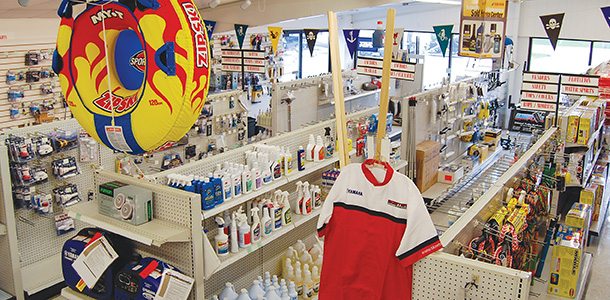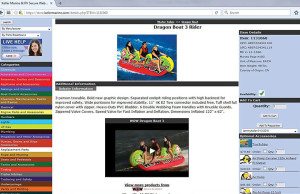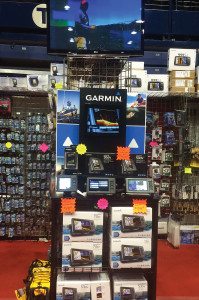Utilizing parts and accessories merchandising to increase sales

There is nothing more impactful than a good first impression.
A parts and accessories department’s design has a huge impact on sales – while the exact layout is ultimately dependent on the space available in the store, making it an attractive area will determine its success.
“It has everything to do with any store’s ability to sell product,” said Jennifer Robison, national retail specialist at Tucker Rocky Distributing.
This means stocking your parts and accessories department at levels that look plentiful, which leads the customer to believe the dealer will always have what they need at the ready.
A parts and accessories department’s design “definitely increases the sales, and I think today’s consumer is so used to seeing full racks of product. So it’s important that the dealer has the showroom looking like they sell a lot of product. They can’t really just have one item on the peg hook; they need to give the consumer the idea that they are in the business,” said Lori Morrow, director of marketing at Keller Marine & RV.
Eye-catching merchandising

When it comes to the layout, Robison recommends a dealer arrange its P&A department in smart ways, such as having dedicated areas for different items like chemicals and lubricants. She says dealers shouldn’t put any items a customer is likely to ask for near the front of the department, such as batteries.
Using Flat Wall displays are very attractive as well and help display product to customers. Morrow encourages dealers to also use double-peg hooks so product can hang on one and the other peg can be used for displaying a plastic card, which houses the UPC, product number and pricing.
“What that allows them to do is quickly scan their store with a scanner to do reorders in our online tool. So it’s multi-faceted. It makes it more attractive but it also allows them a quicker reorder,” said Morrow. “It allows them to see the pricing right there and also the retailer can change their pricing quickly, based on using the little labels, and they can download pricing right from our system to update it.”
Keller Marine helps dealers be more efficient in their ordering process through these UPC tags and a scanner they provide to dealers. This scanner connects to KWeb, a business-to-business system offered by Keller Marine, and when a product is scanned it is automatically entered into the ordering system. This gives the department employees more time to merchandise properly.
Dealers should utilize counter displays as much as possible, as it encourages impulse purchases. Garmin recently introduced a tray kit, a countertop display that complements its recently launched Quatix 3 marine watch (read more about this product in the Products and Services section of the April 2016 issue of Boating Industry).
The merchandising itself needs to be eye catching. Many suppliers provide displays for dealers and these should be used as often as possible to communicate a message to the customers.
“Proper product placement and pricing, and informative copy, is key in these areas. We really try to design fixtures and artwork that are compelling and emotive, but have a fresh design so they draw in the customer and encourage them to check out more,” said Madalyn Radetic, retail merchandising specialist — marine at Garmin. “When we have any new products that are launched, we like to make sure we have off-the-shelf displays for dealers so they can order right away, but obviously we want to make sure these marine dealers also have display fixtures that can be easily transitioned for each product launch.”
Garmin’s in-house merchandising team has helped several dealers create customized displays for its showrooms and P&A departments and is always open to discussing ideas with dealers.

“With those displays, we’re not only highlighting the products, which are often live products that they can interact with, but we have also included iPads where you can go in and check out our mobile apps so they can see how the product works with the apps,” said Radetic. “When we make any sort of merchandising decision, we work really closely with all of the departments here at Garmin.”
Part of communicating a message is offering supplemental materials such as brochures, banners and more to help customers make confident and informed buying decisions, particularly when the part or accessory is expensive. This ultimately helps drive sales.
“We want to make sure our materials are compelling and, more importantly, informative. A lot of these products are very high-end and we want to make sure we are telling our story in the best way possible,” said Radetic. “When you have compelling material and an informative display, you’re encouraging a buyer to come over and find out more, and making it easy for them to make a purchasing decision.”
Interactive merchandising displays have become a trend as they allow customers to experience the product in the store before buying – a huge advantage a brick-and-mortar store has over an online retailer. Suppliers should do everything they can to provide displays for dealers that allow this interactive experience for customers in the P&A department.
“Merchandising is a strategy and it’s a communication tool, and if you’re not merchandising, you’re basically not communicating visually,” said Robison.
Suppliers also need to be sure the merchandising materials they offer dealers are adaptable; obviously, not every dealer is the same and the space availability in a dealership varies widely from business to business.
“We try and make sure the design of our fixtures, displays and temporary POS materials can be applied in all retail environments, whether that’s the physical application of the display or fixture, or it could even be the target marker we’re speaking to: inland, coastal, cruising or sailing markets,” said Radetic. “We just want to make sure that these are adaptable to either a market or a physical fixture in general.”
Time for a refresh
Dealers need to change things up regularly to keep customers interested. If the store looks exactly the same as last time a customer visited, they will get bored quickly.

Robison suggests undergoing a major redesign in merchandising display setup annually, regardless of the size of the dealership. She also recommends changing end caps every couple of months with new products.
“Maybe you put the lubricants on the other side of the counter, something to change it up to get people to do something differently in your store. Customers just want to see new stuff,” Robison said. “You just don’t want to keep the same old stuff all the time, unless it’s really good, solid sellers that are absolutely essentials that your store can’t live without.”
Garmin recommends updating on a quarterly basis, particularly during the peak of the marine season, in the fourth quarter around the holidays during new spring product campaigns.
“Any time a dealer is doing any sort of reset or is bringing in new materials, it’s always kind of nice to be able to provide anew and fresh merchandising to support that,” said Radetic.
Not only does this help build sales by drawing attention to new products, but dealers can support these refreshes by sharing photos on the website or social media. After all, if most customers will visit your website or social media feed before they enter the store, why not entice them with the hot new products you have up for display?
“If you recently reset the store, that’s a good time to do it,” said Robison. “You do yourself a huge disservice by not showing [off your P&A department] and updating it. Change it up once a year, talk about some of the brands you carry. I just want to know [if I am a customer] ‘if I go [to the dealership], what am I going to see?’”




